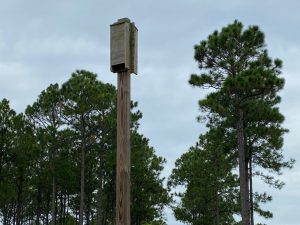Bats bring a beneficial component to your property and community. This flying mammal is an exceptional nocturnal feeder of many insect pests and they are important pollinators of many food plants. However, several challenges face this night flyer, like reduced roosting locations, reduced foraging sights, and over use of pesticides.
There are ways to attract bats to your backyard, farm, and community. Placement of bat boxes with ample water sources nearby is a good start. Water sources are another area of importance to attract bats. Have you sat by a swimming pool and witnessed a bat swoop down and skim across the water? It is likely they are either consuming a little water after feeding on a large number of harmful insects or are wetting their modified arms (wings) to help remove dust and dirt to reduce drag on their wings. Bats are the only mammal that are capable of true flight, the modified wings with skin spanning between specific bone structures allows them to accomplish this amazing action.
We often refer to bats as blind, but they can see shadows if out during daylight hours. This poor sight is not helpful enough for survival, this is where their echolocation abilities come into play. Humans studied bats to better understand how they make the sounds that bounce of an object and back to their sensing system that includes exceptional hearing. They locate and consume insects this way. If this sounds familiar, sonar systems were developed by studying this process.
Bats are the major harvester of night-flying insects, many that carry diseases that impact humans and other animals. Insect prey for bats include cockroaches, mosquitos, moths, beetles, gnats and others. A Big Brown Bat can catch and consume 3,000 to 7,000 mosquitos a night. Multiple this by a large bat population the amount of harmful insects harvested can go into the thousands of tons in a year. This is a positive impact for our forest and agriculture lands against major pests.
Florida is home to 13 different species of bats. They are always on the hunt for warm, dry, dark areas that are either natural or manmade narrow crevices. Out of all of these species, 4 bats are the primary inhabitants of bat houses. The Evening Bat and Brazilian free-tailed Bat are the most common in the panhandle of Florida. The Big Brown Bat and Southeastern Bat can at times occupy houses.
You can often locate bats boxes at your garden and agriculture centers or order online. Another option is to build your own boxes. Just remember the best way to erect a bat box is on a tall post. It is recommended to set the boxes around 10 feet off the ground. Placing boxes on trees creates a setting for potential predators to approach and feed on bats. Snakes have been known to enter and feed on young bats that are not fully developed and at best are poor fliers.
As a reminder, never touch a bat or any other wild animals. Bats that are healthy are not found on the ground, so assume the bat is not health and may be carrying a disease. On a final note, enjoy sitting on the back porch and watching the acrobatics of these amazing mammals in the evening sky.
- Deer Damage in the Landscape - February 22, 2024
- Gardeners: A Critical Link to Protecting Our Water - January 18, 2024
- Propagating Plants by Leaf and Cane - December 14, 2023


